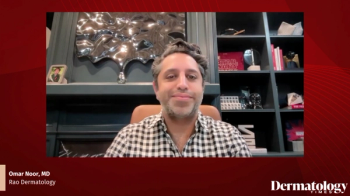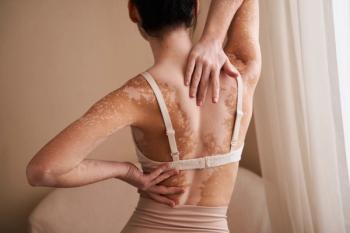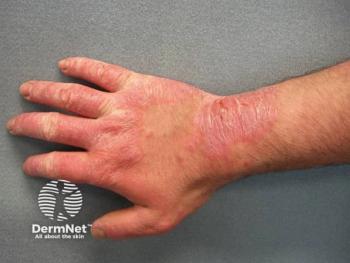
- Dermatology Times, New Directions in Topical Therapy for Atopic Dermatitis, October 2025 (Vol. 46. Supp. 07)
- Volume 46
- Issue 07
3 Cases, 3 Triumphs: Rethinking AD Management
Key Takeaways
- New nonsteroidal topical therapies, such as ruxolitinib, tapinarof, and roflumilast, offer significant improvements for patients with persistent AD.
- Ruxolitinib cream demonstrated rapid itch resolution and skin clearance, breaking the cycle of persistent AD in adolescents.
Explore innovative nonsteroidal treatments for atopic dermatitis, as experts discuss personalized care strategies to enhance patient quality of life.
The clinical landscape for atopic dermatitis (AD) is evolving, and for clinicians navigating this complex field, recent discussions are shedding new light on how to approach treatment for patients who have exhausted traditional options. A recent Dermatology Times Case-Based Roundtable, led by Lawrence Eichenfield, MD, FAAD, moved beyond standard protocols to explore the profound impact of AD on patients' lives and the strategic opportunities presented by new nonsteroidal topical therapies. This was not a discussion of theoretical data, but a practical, empathetic look at the patients behind the presentations.
Case 1: Adolescent with Persistent AD
The first case presented a 17-year-old girl with a long history of AD that had persisted into her teenage years. Despite some success with traditional topical corticosteroids (TCS), she and her family expressed a growing frustration with the disease's persistence. Her experience was a familiar one to many clinicians: "flare-ups are occurring more frequently and the disease is persisting despite using TCS". This constant cycle of inflammation and treatment-induced temporary relief took a significant toll on her quality of life, affecting her sleep and daily activities.
The discussion highlighted the limitations of relying solely on corticosteroids, which can lead to concerns about long-term adverse effects and steroid-phobia. The roundtable proposed an alternative strategy for this patient: initiating treatment with ruxolitinib 1.5% cream, a topical JAK inhibitor. The outcome was a powerful example of the potential of newer therapies. The patient "quickly experienced resolution of her itch, and her skin cleared with continued use," providing a dramatic and life-changing improvement. This case served to illustrate how new mechanisms of action can break the cycle of persistent AD and restore a sense of normalcy for patients.
Case 2: Young Adult with Recurrent Disease
The second case focused on a 23-year-old man whose childhood AD had resurfaced with a vengeance, severely impacting his adult life. After trying a range of topical corticosteroids, tacrolimus, and crisaborole with limited and temporary success, he voiced the frustration of many patients who feel their options have been exhausted. He declared unequivocally, “None of the topicals have been good enough”. This patient was hesitant to start systemic therapy, such as injections, due to a preference for topical solutions and a desire to manage his condition with less invasive methods.
The clinical team decided to initiate him on once-daily topical tapinarof cream, an aryl hydrocarbon receptor agonist. This case was used to demonstrate a key benefit of this new class of medication: the potential for durable remission. The discussion revealed that clinical trials show patients can achieve a median of 75 days of a "treatment-free interval after clearing," a significant quality-of-life benefit. This ability to provide patients with an extended break from the daily burden of applying medication can be a major factor in improving adherence and overall satisfaction with treatment.
Case 3: New Options for a Pediatric Patient
The third case centered on a 9-year-old pediatric patient and underscored the importance of expanding treatment options for younger populations. For pediatric AD, the long-term safety of continuous steroid use is a significant concern for both clinicians and parents. The roundtable introduced roflumilast 0.15% cream, a phosphodiesterase 4 (PDE4) inhibitor, as another new and valuable option for this age group.
The discussion of this case emphasized roflumilast's efficacy and tolerability. Clinical studies have shown promising results, with approximately 30% of patients achieving clear or almost clear skin and a high percentage achieving EASI 75. This provides a nonsteroidal, once-daily option that can be used for both face and intertriginous areas, a common challenge in pediatric AD management. The case highlighted how new therapies are not only improving outcomes for adults but are also providing critical, well-tolerated alternatives for the youngest patients, thereby empowering clinicians with a broader range of tools to customize care.
Conclusion
Overall, these cases collectively illustrated that the modern approach to atopic dermatitis must be both nuanced and proactive. By moving beyond a singular reliance on traditional therapies and embracing the new generation of nonsteroidal topicals, clinicians can provide more effective, personalized care that addresses both the physical symptoms and the significant quality-of-life challenges faced by their patients. The conversation at this roundtable was a powerful reminder that with a broader toolkit and a patient-centered mindset, the future of AD management is brighter than ever.
Articles in this issue
Newsletter
Like what you’re reading? Subscribe to Dermatology Times for weekly updates on therapies, innovations, and real-world practice tips.



















